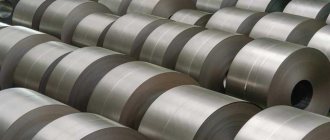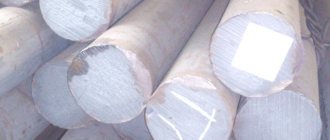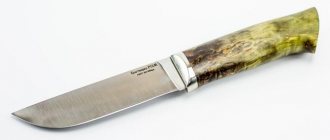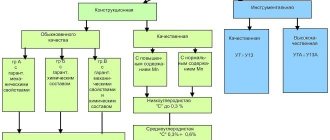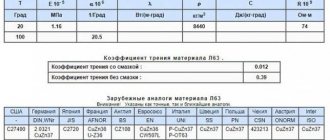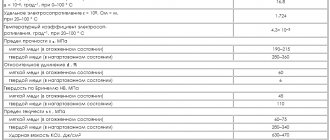General characteristics of steel grade 30ХМА
The heat-resistant relaxation grade 30ХМА belongs to low-alloy medium-carbon steels. It has low flake sensitivity and is not prone to temper brittleness .
30ХМА is characterized by a pronounced uneven distribution of phosphorus and sulfur throughout the thickness of the rolled product. To lower the threshold of cold brittleness and increase the mechanical properties of this grade, alloying elements are introduced into 30KhMA , which form solid solutions and chemical compounds with carbon, iron and other elements and change its properties. In addition, to increase corrosion resistance , a small amount of copper is added to it.
Steel grade 30ХМА is chrome-molybdenum and has limited weldability by manual and automatic submerged arc welding and gas protection. Preheating and subsequent heat treatment are recommended.
| Substitute: | 35ХМ |
| GOST standards: | GOST 8479-70, GOST 1133-71, GOST 8319.0-75, GOST 2590-2006, GOST 2591-2006, GOST 2879-2006, GOST 103-2006, GOST 1051-73, GOST 4543-71, GOST 7417-75, GOST 8559-75, GOST 8560-78, GOST 10702-78, GOST 14955-77, GOST 8732-78 (ST SEV 1481-78), GOST 9567-75, GOST 12132-66, GOST 23270-89 (ISO 2938- 74), GOST 30563-98, GOST 30564-98, GOST 8731-87, GOST R 53383-2009 |
| Application: | general purpose forgings, shafts, rotors and disks of steam turbines, flanges, fasteners with operating temperatures up to 450 degrees, long products |
Read more about the use of 30XMA here >>
Decoding steel grades - Metal Trade LLC
Decoding steel grades
Marking of steels and alloys, how to understand it
The presence of a wide range of steels and alloys produced in different countries has necessitated their identification, but to date there is no unified system for marking steels and alloys, which creates certain difficulties for the metal trade.
Thus, in Russia and the CIS countries (Ukraine, Kazakhstan, Belarus, etc.), an alphanumeric system for designating steel and alloy grades, developed early in the USSR, has been adopted, where, according to GOST, letters conventionally indicate the names of elements and methods of steel smelting, and numbers indicate the content elements.
The European steel designation system is regulated by standard EN 100 27. The first part of this standard determines the order of naming steels, and the second part regulates the assignment of serial numbers to steels.
In Japan, the names of steel grades usually consist of several letters and numbers. The letter designation determines the group to which the steel belongs, and the numbers indicate its serial number in the group and its property.
In the United States, there are several systems for naming metals and their alloys. This is due to the presence of several standardization organizations, these include AMS, ASME, ASTM, AWS, SAE, ACJ, ANSI, AJS. It is quite clear that such marking requires additional clarification and knowledge when trading metal, placing orders, etc.
To date, international standardization organizations have not developed a unified steel marking system.
In this regard, there are discrepancies that lead to errors in orders and, as a result, poor quality of products.
In Russia and the CIS countries, an alphanumeric system has been adopted, according to which numbers indicate the content of steel elements, and letters indicate the name of the elements. Letter designations are also used to indicate the method of deoxidation of steel “KP - boiling steel, PS - semi-quiet steel, SP - calm steel”. There are certain designation features for different groups of steels: structural, construction, tool, stainless steel, etc. The designations common to all are the letter designations of alloying elements: H - nickel, X - chromium, K - cobalt, M - molybdenum, B - tungsten, T - titanium, D - copper, G - manganese, C - silicon.
Structural steels of ordinary quality, unalloyed (GOST 380-94) are designated by the letters ST., for example ST. 3. The number after the letters conventionally indicates the percentage of carbon in the steel.
Structural unalloyed quality steels (GOST 1050-88) are designated by a two-digit number indicating the average carbon content in the steel (for example, ST. 10).
High-quality steels for the production of boilers and high-pressure vessels according to (GOST 5520-79) are designated as structural non-alloy steels, but with the addition of the letter K (for example, 20K).
Structural alloy steels, according to GOST 4543-71, are designated by letters and numbers. The numbers after each letter indicate the approximate content of the corresponding element, however, if the content of the alloying element is less than 1.5%, the number after the corresponding letter is not placed. Qualitative additional indicators, a reduced content of impurities such as sulfur and phosphate, are designated by the letter A or Ш, at the end of the designation, for example (12 X NZA, 18ХГ-Ш), etc.
Cast structural steels, according to GOST 977-88, are designated as high-quality and alloyed, but the letter L is placed at the end of the name.
Construction steels, according to GOST 27772-88, are designated by the letter C and numbers corresponding to the minimum yield strength of the steel. Additionally, the following designations are used: T - heat-strengthened rolled steel, K - increased corrosion resistance (for example, C 345 T, C 390 K, etc.). Similarly, the letter D denotes high copper content.
Bearing steels, according to GOST 801-78, are designated in the same way as alloy steels, but with the letter Ш at the end of the name. It should be noted that for electroslag remelted steels, the letter Ш is denoted by a dash (for example, ШХ 15, ШХ4-Ш).
Unalloyed tool steels, according to GOST 1435-90, are divided into high-quality, denoted by the letter U and a number indicating the average carbon content (for example, U7, U8, U10) and high-quality, denoted by an additional letter A at the end of the name (for example, U8A) or an additional letter G, indicating an additional increase in manganese content (for example, U8GA).
Alloyed tool steels, according to GOST 5950-73, are designated in the same way as structural alloyed steels (for example, 4Х2В5МФ, etc.).
High-speed steels have the letter P in their designation (the designation of steel begins with this), followed by a number indicating the average tungsten content, and then letters and numbers determining the mass content of elements. They do not indicate the chromium content, since it is consistently about 4% in all high-speed steels, and carbon, since the latter is always proportional to the vanadium content. It should be noted that if the vanadium content exceeds 2.5%, the letter F and number are indicated (for example, steel R6M5 and R6 M5F3).
Standard stainless steels, according to GOST 5632-72, are marked with letters and numbers according to the principle adopted for structural alloy steels (for example, 08Х18Н10Т or 16Х18Н12С4ТУЛ).
Stainless steel, non-standard experimental batches are designated by letters - indices of the manufacturer's plant and serial numbers. The letters EI, EP, or EK are assigned to steels smelted for the first time, ChS - to steels smelted in Chelyabinsk, DI - to steels smelted, for example, EI-435, ChS-43, etc. To indicate the method of smelting and finishing, the names of a number of steels are supplemented with letters (for example, 13Х18Н10 -VI), which means vacuum induction smelting.
International analogues of corrosion-resistant and heat-resistant steels
Corrosion-resistant steels
| Europe (EN) | Germany (DIN) | USA (AISI) | Japan (JIS | CIS (GOST) |
| 1.4000 | X6Cr13 | 410S | SUS 410 S | 08Х13 |
| 1.4006 | X12CrN13 | 410 | SUS 410 | 12Х13 |
| 1.4021 | X20Cr13 | -420 | SUS 420 J1 | 20Х13 |
| 1.4028 | X20Cr13 | -420 | SUS 420 J2 | 30Х13 |
| 1.4031 | X20Cr13 | SUS 420 J2 | 40Х13 | |
| 1.4034 | X20Cr13 | -420 | 40Х13 | |
| 1.4016 | X6Cr17 | 430 | SUS 430 | 12Х17 |
| 1.4510 | X3CrTi17 | 439 | SUS 430 LX | 08Х17Т |
| 1.4301 | X5CrNI18-10 | 304 | SUS 304 | 08Х18Н10 |
| 1.4303 | X4CrNi18-12 | -305 | SUS 305 | 12Х18Н12 |
| 1.4306 | X2CrNi19-11 | 304 L | SUS 304 L | 03Х18Н11 |
| 1.4541 | X6CrNiTi18-10 | 321 | SUS 321 | 08Х18Н10Т |
| 1.4571 | X6CrNiMoTi17-12-2 | 316 Ti | SUS 316 Ti | 10Х17Н13М2Т |
Heat-resistant steels
| Europe (EN) | Germany (DIN) | USA (AISI) | Japan (JIS | CIS (GOST) |
| 1.4878 | X12CrNiTi18-9 | 321H | 12Х18Н10Т | |
| 1.4845 | X12CrNi25-21 | 310 S | 20Х23Н18 |
metall-traid.ru
Steel 38ХА structural alloy
Substitutes
Foreign analogues
IMPORTANT. The possibility of replacement is determined in each specific case after assessing and comparing the properties of steels
Type of delivery
- Long products, including shaped steel: GOST 4543-71, GOST 2590-88, GOST 2591-88, GOST 2879-88, GOST 10702-78.
- Calibrated rod GOST 7417-75, GOST 8559-75, GOST 8560-78, GOST 1051-73.
- Polished rod and silver GOST 14955-77.
- Thick sheet GOST 1577-93, GOST 19903-74.
- Strip GOST 103-76, GOST 82-70.
- Forgings and forged blanks GOST 1133-71.
- Pipes GOST 21729-76.
Application
Steel grade 38ХА is used for the manufacture of the following parts:
- Worms,
- gear wheels,
- gears,
- shafts,
- axles,
- critical bolts and other upgradeable parts.
In the oil, petrochemical and gas industries, grade 38ХА steel is used for the manufacture of:
Temperature of use of steel 38ХА for northern machine parts
| Steel | Temperature after hardening, °C | σв, kgf/mm2 | Application temperature, °C (not lower) | Part thickness, mm (no more) |
| 38XA | 500 | 95 | -60 | 25 |
Steel 30ХМ (30ХМА) structural alloy
Decoding
- According to GOST 4543-2016, the number 30 in the designation of steel indicates the average mass fraction of carbon in steel in hundredths of a percent, i.e. carbon in steel 30ХМ is about 0.30%
- The letter X indicates that the steel contains chromium (Cr), the absence of numbers behind the letter indicates that the steel contains up to approximately 1.5% chromium.
- The letter M indicates that the steel contains molybdenum (Mo), the absence of numbers behind the letter indicates that the steel contains up to 1.5% molybdenum.
- The presence of the letter A at the end of the steel grade designation indicates that 30ХМА steel is high-quality, i.e. with increased requirements for the chemical composition and macrostructure of metal products made from it compared to high-quality steel.
Substitute
| Replaceable steel grade | Steel substitutes | |||
| 30ХМ (30ХМА) | 35ХМ | 35HPA | ||
Foreign analogues [1, 2]
| Designation of steel grade, (country) | Standard | Other name |
| 15 131 (Czech Republic/Slovakia) | CSN 415131 | |
| 2225 (Sweden) | SS | OVAKO 522 (S-6) |
| 4130 (US) | SAEI404, AISI | G 41300, 6348 A (AMS) |
| 1717 CDS 110 UK | B.S. | |
| 4130 (Australia) | AS 1444 (86) | |
| 25 CD 4 (France) | AFNOR.NF A-35-556 (84) | F 66S (F-05) |
| 30CrMo4 (Italy) | UNI 6403 (86) | D 221 (1-04), UM6 (1-07) |
| 25CrMo4 (Germany) | EN10083-1, DIN 1652 T.4, DIN 1654 T.4, DIN 17176, DIN 17204, E17201 | 1.7218 |
| 30ChM (Bulgaria) | BDS 6550 | |
| 25CrMo4 (Spain) | UNE 36 051-91 (1) | |
| 25CrMo4 (European standards) | EN 10083-1 (91) | |
| 30CrMo (China) | GB3077-88 | |
| S4730 (Yugoslavia) | JUS C.B9.021 | |
| F.222 (Spain) | — | A-222 (E-2) |
| SCM 430 (Japan) | JIS | |
| SCM2 (Japan) | JIS G4105 (74) | |
| 30HN (Poland) | PN/H 84030/04 |
Chemical composition, % (GOST 4543-2016)
| steel grade | Mass fraction of elements, % | |||||||||
| WITH | Si | Mn | Cr | Ni | Mo | Al | Ti | V | B | |
| 30ХМ | 0,26-0,34 | 0,17-0,37 | 0,40-0,70 | 0,80-1,10 | — | 0,15-0,25 | — | — | — | — |
| 30ХМА | 0,26-0,33 | 0,17-0,37 | 0,40-0,70 | 0,80-1,10 | — | 0,15-0,25 | — | — | — | — |
Type of delivery
- Long products, including shaped steel: GOST 4543-71, GOST 2590-88, GOST 2591-88, GOST 2879-88.
- Calibrated rod GOST 7417-75, GOST 8559-75, GOST 8560-78, GOST 1051-73.
- Polished rod and silver GOST 14955-77.
- Strip GOST 103-76.
- Forgings and forged blanks GOST 1133-71, GOST 8479-70.
- Pipe GOST 8731-74, GOST 8732-78.
Characteristics and properties [3]
Chrome-molybdenum steel 30ХМ (30ХМА) is a structural alloy steel that can be improved. The usual heat treatment of such steels is oil quenching and high tempering (550-650°C).
The hardenability of 30ХМ is slightly higher than that of 40Х steel, but the cold brittleness threshold is lower; in addition, 30ХМ steel is insensitive (like other molybdenum steels) to type II temper brittleness.
Purpose
- shafts,
- gears,
- spindles,
- hairpins,
- flanges,
- disks,
- tires
- rods and other critical parts operating under conditions of heavy loads and speeds at temperatures up to 450-500 °C.
- Jet engine power parts operating at temperatures up to 450°C.
The use of 30KhMA steel as a pipeline material depending on the parameters of the transported medium (GOST 32569-2013)
| Technical requirements for pipes (standard or specifications) | Nominal diameter, mm | Types of tests and requirements (standard or specifications) | Transported medium | Pipeline design parameters | ||||
| Maximum pressure, MPa | Maximum temperature, °C | Pipe wall thickness, mm | Minimum temperature depending on the pipe wall thickness with stress in the wall from internal pressure [σ], °C | |||||
| more than 0.35[σ] | no more than 0.35[σ] | |||||||
| TU 14-3-433-78 TU 14-3-251-74 | 6-500 | TU 14-3-433-78 TU 14-3-251-74 | All environments (see tables 5.1 (GOST 32569-2013)) | ≤80 | 450 | — | minus 30 | minus 50 |
The use of steel 30ХМ and 30ХМА as a material for the manufacture of fasteners (GOST 32569-2013)
| steel grade | Technical requirements | Acceptable operating parameters | Purpose | |
| Wall temperature, °C | Medium pressure, MPa (kgf/cm2), no more | |||
| 30ХМ, 30ХМА GOST 4543 | STP 26.260.2043 | -40 to +450 | 16(160) | Studs, bolts |
| -40 to +510 | Nuts | |||
| -70 to +450 | Washers | |||
Limits of application, types of mandatory testing and control of steel 30ХМА for flanges, lenses, gaskets and fasteners for pressures above 10 MPa (100 kgf/cm2) (GOST 32569-2013)
| Steel grade, standard or specification | 30ХМА | ||||
| GOST | 10494 | 10495 | 9399 | 10493 | |
| the name of detail | Hairpins | Nuts | Flanges | Lenses | |
| Limit parameters | Wall temperature, °C, no more | -50 to +400 | -50 to +510 | -50 to +400 | |
| Nominal pressure, MPa (kgf/cm2) no more | 80 (800) | 100 (1000) | 80 (800) | ||
| Mandatory tests | σ0.2 | + | + | + | + |
| σв | + | + | + | + | |
| σ | + | + | + | + | |
| f | + | — | + | — | |
| KCU | + | + | + | + | |
| HB | + | + | + | + | |
| Control | Flaw detection | + | — | + | + |
| Non-metallic inclusions | — | — | — | + | |
Maximum permissible temperature for the use of 30KhMA steel in hydrogen-containing environments, °C (GOST 32569-2013)
| Temperature, °C, at partial pressure of hydrogen, MPa (kgf/cm2) | ||||||
| 1,5 (15) | 2,5 (25) | 5 (50) | 10 (100) | 20 (200) | 30 (300) | 40 (400) |
| 400 | 390 | 370 | 330 | 290 | 260 | 250 |
Maximum permissible temperatures for the use of 30KhMA steel in environments containing ammonia, °C (GOST 32569-2013)
| Temperature, °C at ammonia partial pressure, MPa (kgf/cm2) | ||
| From 1 (10) to 2 (20) | From 2 (20) to 5 (50) | From 5 (50) to 8 (80) |
| 340 | 330 | 310 |
Conditions for using 30ХМА steel for bodies, covers, flanges, membranes and valve assembly made from rolled products, forgings (stampings) (GOST 33260-2015)
| ND for supply | Temperature of the working medium (wall), °C | Additional instructions for use |
| Long products GOST 4543. Forgings GOST 8479 | -50 to 450 | For non-welded fittings with mandatory heat treatment (hardening and high tempering) at a temperature of the working medium (wall) below minus 40°C to minus 50°C |
Conditions for using 30KhMA steel for reinforcement fasteners (GOST 33260-2015)
| Material grade, class or group according to GOST 1759.0 | Material standard or specification | Application options | |||||
| Bolts, studs, screws | Nuts | Flat washers | |||||
| Ambient temperature, °C | Nominal pressure PN, MPa (kgf/cm2) | Ambient temperature, °C | Nominal pressure, MPa (kgf/cm2) | Ambient temperature, °C | Nominal pressure, MPa (kgf/cm2) | ||
| 30ХМА | GOST 4543 | -40 to 450 | Not regulated | -40 to 510 | Not regulated | -70 to 450 | Not regulated |
NOTE. It is allowed to use fasteners made of steel grade 30ХМА at temperatures below minus 40°C to minus 60°C, if during impact bending tests on samples of type 11 according to GOST 9454 at operating temperatures below zero, the impact strength is not lower than 300 kJ/m2 (3 kgf* m/cm2) on any of the tested samples.
Recommendations for the use of steel 30ХМА for parts of valves and pneumatic actuators that do not operate under pressure and are not subject to welding, intended for operation at low temperatures (GOST 33260-2015)
| Quenching + tempering at temperature, °C | Approximate strength level, N/mm2 (kgf/mm2) | Application temperature not lower, °C | Use in thickness no more than, mm |
| 550 | 950 (95) | -80 | 30 |
Resistance of steel 30ХМА against crevice erosion (GOST 33260-2015)
| Durability group | Point | Erosion resistance against steel 12X18H10T | Material |
| Reduced durability | 4 | 0,15-0,25 | Forged alloy pearlitic steel 30ХМА, containing up to 1.5% chromium, heat treated at KP50 - KP75 and its welded joints |
NOTE. The coefficient of erosion resistance of a material is the ratio of the rate of erosive wear of the material to the rate of erosive wear of steel 12Х18Н10Т (taken as 1).
Recommended heat treatment of steel 30ХМА [4]
- Preliminary heat treatment: normalization at 900°C, tempering at 670°C.
- Final heat treatment: hardening at 880±10°C in oil, tempering at 550-650°C with cooling in oil or water.
Approximate heat treatment regimes for 30ХМ steel [5]
| steel grade | Heat treatment operation | Temperature, °C | Cooling method | Hardness HB |
| 30ХМ | Normalization | 840-860 | On air | 207-255 |
| Annealing | 830-850 | Slow | 187-229 |
Heat treatment modes for steel 30ХМ and 30ХМА [5]
| steel grade | Heat treatment | |||
| Hardening | Vacation | |||
| Temperature, °C | Cooling medium | Temperature, °C | Cooling medium | |
| 30ХМ | 880 | Oil | 540 | Water or oil |
| 30ХМА | ||||
Brinell hardness of metal products made from steel 30ХМ and 30ХМА (GOST 4543-2016)
| steel grade | Hardness NV, no more |
| 30ХМ | 229 |
| 30ХМА | 229 |
NOTE. Brinell hardness is indicated for metal products in the annealed (OT) or high-tempered (HT) state, as well as hot-rolled and forged metal products, normalized with subsequent high tempering (H+HT), with a diameter or thickness of over 5 mm.
Mechanical properties of metal products made from steel 30ХМ (30ХМА) (GOST 4543-2016)
| steel grade | 30ХМ | 30ХМА | |||
| Heat treatment mode | Hardening | Temperature, °C | 1st hardening or normalization | 880 | |
| 2nd hardening | — | ||||
| Cooling medium | Oil | ||||
| Vacation | Temperature, °C | 540 | |||
| Cooling medium | Water or oil | ||||
| Mechanical properties, no less | Yield strength σТ, N/mm2 | 735 | |||
| Tensile strength σв, N/mm2 | 930 | ||||
| Relative | elongation δ5, % | 11 | 12 | ||
| narrowing ψ, % | 45 | 50 | |||
| Impact strength KCU, J/cm2 | 78 | 88 | |||
| Sectional size of workpieces for heat treatment (circle diameter or square side), mm | 15 | ||||
Mechanical properties depending on the section [6]
| Section, mm | Sample cutting location | σ0.2, MPa | σв, MPa | δ5, % | ψ, % | KCU, J/cm2 | Hardness HRCе |
| Hardening at 880°C in oil; tempering at 500°C | |||||||
| 40 | C | 650 | 820 | 17 | 71 | 147 | 27 |
| 60 | C | 630 | 800 | 17 | 69 | 157 | 27 |
| 80 | 1/2R | 660 | 790 | 17 | 67 | 137 | 25 |
| 100 | 1/2R | 610 | 780 | 18 | 64 | 147 | 25 |
| 120 | 1/3R | 620 | 750 | 19 | 63 | 137 | — |
| Quenching at 880°C in water; tempering at 500°C | |||||||
| 40 | C | 790 | 930 | 13 | 61 | 118 | 30 |
| 60 | C | 740 | 870 | 16 | 64 | 127 | 31 |
| 80 | 1/2R | 760 | 890 | 14 | 64 | 108 | 30 |
| 100 | 1/2R | 700 | 830 | 17 | 65 | 137 | 27 |
| 120 | 1/3R | 690 | 840 | 18 | 63 | 118 | 25 |
Mechanical properties depending on tempering temperature
| tref., °C | σ0.2, MPa | σв, MPa | δ5, % | ψ, % | KCU, J/cm2 | Hardness HRCе |
| 200 | 1320 | 1520 | 12 | 50 | 69 | 49 |
| 300 | 1330 | 1450 | 11 | 51 | 49 | 45 |
| 400 | 1220 | 1370 | 12 | 55 | 69 | 42 |
| 500 | 1080 | 1130 | 16 | 60 | 127 | 36 |
Note. Hardening at 880°C in oil.
Mechanical properties at elevated temperatures [6]
| tsp., °C | σ0.2, MPa | σв, MPa | δ5, % | ψ, % | KCU, J/cm2 |
| Hardening at 880°C in oil; tempering at 650°C | |||||
| 260 | 590 | 730 | 20 | 70 | 186 |
| 200 | 490 | 660 | 21 | 70 | — |
| 300 | 520 | 710 | 21 | 69 | 206 |
| 400 | 480 | 630 | 22 | 75 | 199 |
| 500 | 430 | 500 | 22 | 80 | 142 |
| 600 | 340 | 330 | 29 | 89 | 142 |
| Sample 6 mm in diameter, 30 mm long, pressed. Deformation speed 16 mm/min; strain rate 0.009 1/s | |||||
| 800 | 80 | 130 | 69 | 67 | — |
| 1000 | 41 | 56 | 64 | 100 | — |
| 1200 | 14 | 26 | 55 | 100 | — |
Endurance limit
| Strength characteristics and heat treatment | σ-1, MPa | n |
| σ0.2 = 710 MPa, σв = 820 MPa. Quenching at 870°C in water; tempering at 600°C [7] | 407 | 10′ |
| σ0.2 = 710 MPa, σв = 850 MPa, НВ 260. Quenching from 880°C in oil; tempering at 560°C [8] | 366 | — |
| σ0.2 = 530 MPa, σв = 730 MPa, НВ 212. Quenching from 880°C in oil; tempering at 650°C [8] | 304 | — |
Impact strength KCU [6]
| Heat treatment | KCU, J/cm2, at temperature, °C | ||
| -20 | -40 | -60 | |
| Hardening at 880°C in oil; tempering at 350°C. Hardening from 880°C; tempering at 550°C | 147 | 42 | 108 |
Mechanical properties during long-term strength testing [9]
| Creep limit, MPa | Creep rate, %/h | Long-term strength limit, MPa | t,°C | Duration, h | t,°C |
| 137 | 1/10000 | 500 | 186 | 10000 | 500 |
| 69 | 1/100000 | 500 | 127 | 100000 | 500 |
| 59 | 1/10000 | 550 | 108 | 10000 | 550 |
| 34 | 1/100000 | 550 | 69 | 100000 | 550 |
Technological properties [10]
- Forging temperature, °C: beginning 1260, end 760-800. Sections up to 100 mm are cooled in air, sections 101-300 mm are cooled in a mold.
- Weldability - limited weldability. Welding methods: RDS, ADS submerged arc and gas shield. Preheating and subsequent heat treatment are recommended.
- Cutting machinability - Kv tv.spl = 0.7 and Kv b.st. = 0.3 MPa after hardening and tempering at HB 229-269 σw = 930 MPa.
- Flock sensitivity is insensitive.
- Tendency to temper brittleness - not prone.
Density ρп kg/cm3 at test temperature, °C
| Steel | 20°C | 100°C | 200°C | 300°C | 400°C | 500°C |
| 30ХМ | 7820 | 7800 | 7770 | 7740 | 7700 | 7660 |
| 30ХМА | 7820 | 7800 | 7770 | 7740 | 7700 | 7660 |
Linear expansion coefficient α*106, K-1
| steel grade | α*106, K-1 at test temperature, °C | ||||
| 20-100 | 20-200 | 20-300 | 20-400 | 20-500 | |
| 30ХМ | 11,5 | 12,5 | 13,2 | 13,8 | 14,3 |
| 30ХМА | 11,6 | 12,5 | 13,2 | 13,8 | 14,3 |
Thermal conductivity coefficient λ W/(m*K)
| Steel grade | λ W/(m*K), at test temperature, °C | ||||||||
| 20 | 100 | 200 | 300 | 400 | 500 | 600 | 700 | 800 | |
| 30ХМ | — | 46 | 44 | 42 | 42 | 39 | 37 | 36 | 32 |
| 30ХМА | — | 46 | 44 | 42 | 42 | 39 | 37 | 36 | 32 |
Young's modulus (normal elasticity) E, GPa
| Steel grade | At test temperature, °C | ||||||
| 20 | 100 | 200 | 300 | 400 | 500 | 600 | |
| 30ХМ | 208 | 207 | 204 | 197 | 188 | 176 | 160 |
| 30ХМА | 208 | 207 | 204 | 197 | 188 | 176 | 160 |
Specific heat capacity c, J/(kg*K)
| steel grade | s, J/(kg*K), at test temperature, °C |
| 20-100 | |
| 30ХМ | 462 |
| 30ХМА | 462 |
Electrical resistivity ρ nom*m
| steel grade | ρ nom*m, at test temperature, °C |
| 20 | |
| 30ХМ | 230 |
| 30ХМА | 230 |
Bibliography
- Shishkov M.M. Brand of steels and alloys - 2000
- ST TsKBA 005yu3-2009
- Gulyaev A.P. Metallurgy. 1986
- Sklyarov N.M. Structural steels T1 - 1975
- Firger I.V. Heat treatment of alloys. Directory - 1982
- Materials in mechanical engineering. T.2. Structural steel: Handbook / Ed. I.V. Kudryavtsev, E.P. Mogilevsky. - M.: Mechanical Engineering, 1967.-496 p.
- Gulyaev A.P., Meshcherinova O.N., Trifonova T.N. The influence of boron on the properties of alloyed structural steels / S. scientific. tr. TsNIIChM. 1962. Special steels and alloys. Vol. 27. - M.: Metallurgy, P.29-46
- Vashchenko K.I., Rostovtsev L.I., Alenkevich A.V. Nickel-free sptals for casting grates for refrigerators of cement kilns / Foundry production. 1973. No. 6. pp. 22-23.
- Mikhailov-Mikheev P.B. Handbook of metal materials for turbine and engine construction. -M. -L.: Mechanical Engineering, 1961.
- Brand of steels and alloys / Ed. V.G. Sorokina. - M.: Mechanical Engineering, 1989.-639 p.
Find out more
Structural alloy steel 40ХН2МА...
Steel 08Х17Т (EI645) corrosion-resistant, heat-resistant…
Structural alloy steel 50G…
Structural alloy steel 40X2H2MA…
Steel 30ХМА - decoding of steel grade, GOST, material characteristics
Steel grade - 30ХМА
Standard - GOST 4543
Substitute - 35ХМ, 35ХРА
Steel 30ХМА
contains an average of 0.3% carbon,
X
- indicates the chromium content in steel is approximately 1%,
M
- indicates the molybdenum content in steel up to 1%, the letter
A
at the end of the brand means that the steel is high quality.
Alloy structural steel 30ХМА is used for parts operating at high temperatures (up to 500°C): shafts, turbine rotors and disks, fasteners, etc.
Steel has increased hardenability.
| Mass fraction of basic chemical elements, % | ||||
| C - carbon | Si - silicon | Mn - manganese | Cr - chromium | Mo - molybdenum |
| 0,26-0,33 | 0,17-0,37 | 0,40-0,70 | 0,80-1,10 | 0,15-0,25 |
| Temperature of critical points, °C | |||
| Ac1 | Ac3 | Ar1 | Ar3 |
| 757 | 807 | 693 | 763 |
| Technological properties | |
| Forging | Forging temperature, °C: beginning 1260, end 760-800. Sections up to 100 mm are cooled in air, from 101-300 mm - in a mold. |
| Weldability | Limited weldability. Welding methods: manual arc welding, automatic arc welding, resistance welding. Preheating and subsequent heat treatment are recommended. |
| Machinability | After quenching and tempering at HB 229-269 and σв = 930 MPa: Kv carbide = 0.7 Kv high-speed steel = 0.3 |
| Flock sensitivity | Insensitive |
| Tendency to temper brittleness | Not inclined |
| Physical properties | Test temperature, °C | |||||||||
| 20 | 100 | 200 | 300 | 400 | 500 | 600 | 700 | 800 | 900 | |
| Modulus of normal elasticity E, GPa | 208 | 207 | 204 | 197 | 188 | 176 | 160 | — | — | — |
| Modulus of elasticity under torsional shear G, GPa | — | — | — | — | — | — | — | — | — | — |
| Density ρn, kg/m3 | 7820 | 7800 | 7770 | 7740 | 7700 | 7660 | — | — | — | — |
| Thermal conductivity coefficient λ W/(m*K) | — | 46 | 44 | 42 | 42 | 39 | 37 | 36 | 32 | — |
| Electrical resistivity ρ, nOhm*m | 230 | — | — | — | — | — | — | — | — | — |
| 20-100 | 20-200 | 20-300 | 20-400 | 20-500 | 20-600 | 20-700 | 20-800 | 20-900 | 20-1000 | |
| Linear expansion coefficient α*106, K-1 | 11,6 | 12,5 | 13,2 | 13,8 | 14,3 | — | — | — | — | — |
| Specific heat capacity c, J/(kg*K) | 462 | — | — | — | — | — | — | — | — | — |
tekhnar.ru
